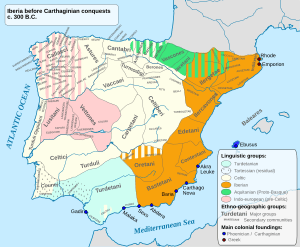Lusones facts for kids
The Lusones were an ancient group of people who lived in the Iberian Peninsula. This area is now Spain and Portugal. They were part of a larger group called the Celtiberians. The Lusones lived in the high valley of the Tajuña River, near what is now Guadalajara. They were a strong group, but the Romans defeated them by the end of the 2nd century BC.
Who Were the Lusones?
The Lusones spoke a language called Celtiberian. This language was a type of Celtic language. They were one of many groups that made up the Celtiberians. Experts believe that the ancestors of the Celtiberians lived in the central part of the Iberian Peninsula as early as 1000 BC.
The Lusones were a mix of different peoples. Some of their ancestors might have come from early Italic groups. Others might have been related to Gauls, who lived in what is now France. Some historians think they might have been connected to the Helvetii from Switzerland. It's also possible they were related to the Lusitani, another ancient group in the Iberian Peninsula.
Where Did the Lusones Live?
Ancient writers like Strabo and Appian described where the Lusones lived. They were located in the Aragonese region of Spain. Their lands were along the middle Ebro River, near the Moncayo Massif mountain range. This area included parts of western Zaragoza and most of Soria. It also stretched into northeastern Guadalajara and southern Navarre provinces.
The main city of the Lusones was likely Turiaso. Today, this place is known as La Oruña or Vera de Moncayo. Other important towns included:
- Calagurris (now Calahorra in La Rioja)
- Cascantum (now Cascante in Navarre)
- Bursau (now Borja in Zaragoza)
- Carabis (now Magallón in Zaragoza)
The Lusones also helped establish other towns. One was Complega, a place known for its "bandits." They also helped found the Roman settlement of Grachurris. This town was started by a Roman leader named Tiberius Sempronius Gracchus the Elder in 181 BC.
What Was Their History?
In the 3rd and 2nd centuries BC, the Lusones joined forces with their neighbors. These groups included the Arevaci, Belli, and Titii. Together, they formed the Celtiberian Confederacy. This alliance fought against Rome in a series of conflicts called the Celtiberian Wars.
The Lusones faced a major defeat by the Roman general Quintus Caecilius Metellus Macedonicus in 142 BC. Even though Rome forced them to become part of the Roman province of Hispania Citerior, they kept fighting.
The Lusones remained a strong fighting force. They joined the Arevaci and Pellendones in revolts against Rome. These uprisings happened throughout the 1st century BC. However, these battles weakened the Lusones' military. By the middle of the century, another group, the Vascones, pushed them out of their lands along the Ebro River. The Vascones took over four of their key border towns, including Grachurris.
The Lusones mostly disappear from historical records after the Sertorian Wars ended in 72 BC. It's believed that they either joined or were absorbed by their neighbors, the Belli and Titii.
See also
Template:Kids robot.svg In Spanish: Lusones para niños
- Celtiberian confederacy
- Celtiberian script
- Celtiberian Wars
- Helvetii
- Numantine War
- Pre-Roman peoples of the Iberian Peninsula



